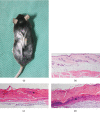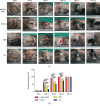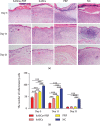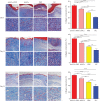Synergistic Effects of Human Platelet-Rich Plasma Combined with Adipose-Derived Stem Cells on Healing in a Mouse Pressure Injury Model
- PMID: 31781237
- PMCID: PMC6874957
- DOI: 10.1155/2019/3091619
Synergistic Effects of Human Platelet-Rich Plasma Combined with Adipose-Derived Stem Cells on Healing in a Mouse Pressure Injury Model
Abstract
Pressure injury (PI) affects quality of life and results in economic and social burdens. Local transplantation of human adipose-derived stem cells (ASCs) is considered an effective treatment. However, ASC suspension alone is vulnerable to the immune system and results in a shortened cell survival. There is increasing evidence of a synergistic effect of platelet-rich plasma (PRP) combined with ASCs on wound healing. This study investigated the effectiveness, synergy, and mechanism of wound healing following local injection of PRP combined with ASCs in a rodent PI model. PRP or ASCs alone were the control intervention. Wound healing, inflammatory infiltration, collagen deposition, angiogenesis, neurogenesis, and cell homing were investigated. PI healing was promoted by the synergistic effects of PRP combined with ASCs. The combination was more effective than ASCs alone for modulating inflammation, increasing collagen deposition, angiogenesis, neurogenesis, and the persistence of the injected ASCs. These data provide a theoretical foundation for the clinical administration of ASCs combined with PRP in PI healing and skin regeneration.
Copyright © 2019 Zhiyuan Liu et al.
Conflict of interest statement
The authors have no competing financial interests to declare.
Figures








Similar articles
-
[Effects of human adipose-derived mesenchymal stem cells and platelet-rich plasma on healing of wounds with full-thickness skin defects in mice].Zhonghua Shao Shang Za Zhi. 2018 Dec 20;34(12):887-894. doi: 10.3760/cma.j.issn.1009-2587.2018.12.013. Zhonghua Shao Shang Za Zhi. 2018. PMID: 30585053 Chinese.
-
Platelet rich plasma hydrogels promote in vitro and in vivo angiogenic potential of adipose-derived stem cells.Acta Biomater. 2019 Mar 15;87:76-87. doi: 10.1016/j.actbio.2019.01.039. Epub 2019 Jan 18. Acta Biomater. 2019. PMID: 30665019
-
[Effect of human adipose-derived stem cells on pressure ulcer healing in mouse].Zhongguo Xiu Fu Chong Jian Wai Ke Za Zhi. 2018 Jun 15;32(6):726-735. doi: 10.7507/1002-1892.201801031. Zhongguo Xiu Fu Chong Jian Wai Ke Za Zhi. 2018. PMID: 29905053 Free PMC article. Chinese.
-
Augmentation of Dermal Wound Healing by Adipose Tissue-Derived Stromal Cells (ASC).Bioengineering (Basel). 2018 Oct 26;5(4):91. doi: 10.3390/bioengineering5040091. Bioengineering (Basel). 2018. PMID: 30373121 Free PMC article. Review.
-
Adipose-derived stem cells for wound healing.J Cell Physiol. 2019 Jun;234(6):7903-7914. doi: 10.1002/jcp.27922. Epub 2018 Dec 4. J Cell Physiol. 2019. PMID: 30515810 Review.
Cited by
-
Synergistic effect of nanofat and mouse nerve-growth factor for promotion of sensory recovery in anterolateral thigh free flaps.Stem Cells Transl Med. 2021 Feb;10(2):181-189. doi: 10.1002/sctm.20-0226. Epub 2020 Oct 11. Stem Cells Transl Med. 2021. PMID: 33043628 Free PMC article.
-
The effects of mesenchymal stromal cells and platelet-rich plasma treatments on cutaneous wound healing.Arch Dermatol Res. 2023 May;315(4):815-823. doi: 10.1007/s00403-022-02451-y. Epub 2022 Nov 3. Arch Dermatol Res. 2023. PMID: 36326886
-
HUC-MSCs combined with platelet lysate treat diabetic chronic cutaneous ulcers in Bama miniature pig.Regen Ther. 2024 Nov 20;26:1138-1149. doi: 10.1016/j.reth.2024.11.005. eCollection 2024 Jun. Regen Ther. 2024. PMID: 39640920 Free PMC article.
-
Self-assembled polyelectrolyte complexes of chitosan and fucoidan for sustained growth factor release from PRP enhance proliferation and collagen deposition in diabetic mice.Drug Deliv Transl Res. 2022 Nov;12(11):2838-2855. doi: 10.1007/s13346-022-01144-3. Epub 2022 Apr 21. Drug Deliv Transl Res. 2022. PMID: 35445942
-
Promotion of Hair Growth by Conditioned Medium from Extracellular Matrix/Stromal Vascular Fraction Gel in C57BL/6 Mice.Stem Cells Int. 2020 Jun 13;2020:9054514. doi: 10.1155/2020/9054514. eCollection 2020. Stem Cells Int. 2020. PMID: 32612663 Free PMC article.
References
-
- Black J., Baharestani M., Cuddigan J., et al. National Pressure Ulcer Advisory Panel’s updated pressure ulcer staging system. Dermatology Nursing. 2007;19(4):343–349. quiz 50. - PubMed
LinkOut - more resources
Full Text Sources
Research Materials
Miscellaneous

